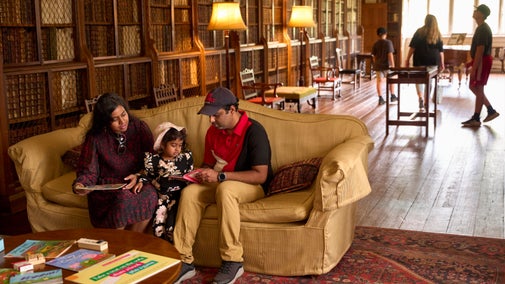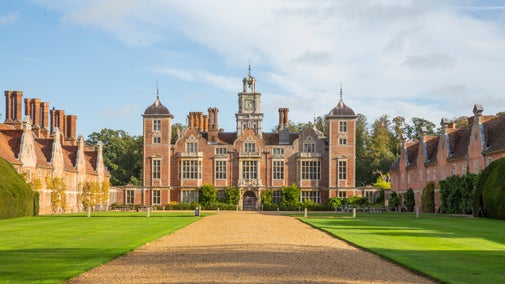
Donate
Everyone needs nature, now more than ever. Donate today and you could help people and nature to thrive at the places we care for.

Behind the scenes, the team at Blickling clean, protect and conserve the hall and collections items.
The collections and house team start the day by dusting and vacuuming the show rooms. Objects are condition checked and any issues identified. Once the daily clean has taken place, the front door is ready to be opened to welcome everyone inside.
Looking after the house isn’t just about keeping the rooms clean and tidy. We have detailed work routines checking the condition of the entire collection:
Why is it so dark? It is important that light levels are kept low so that none of the objects in the collection fade. Relative humidity levels (how damp the air is) are also checked on a regular basis. When it is too dry, objects can crack and warp. If it is too damp mould can grow and pests thrive.
A dedicated volunteer team work with staff to look after the large collection of over 12,500 volumes at Blickling. The books are checked and cleaned one-by-one, using a soft pony hair brush and a conservation vacuum.
The house team monitor the numbers of pests found in the house. These insects feed on the collection. Silverfish, moths, carpet, furniture and deathwatch beetles have been found in the hall. We check and control their numbers to prevent damage to the collection.

In 2021, the house team embarked on a groundbreaking new pest-control trial to tackle webbing clothes moths (Tineola bisselliella), using natural methods, not previously used together in a heritage setting.
The trial used a microscopic parasitoid wasp, (Trichogramma evanescens), together with moth pheromones, and the Trust’s existing moth-control regime, to target the whole lifecycle of the moth (adult, larva and egg). If left unchecked the moths cause serious damage to carpets, furniture, clothing and other wool and silk objects.
The microwasps (barely visible to the human eye) are a natural enemy of the clothes moth. They search out moth eggs and laytheir own eggs inside. A new wasp hatches, rather than a moth larva. Once the wasp eggs are laid, the wasps die naturally and disappear into house dust.
Special tabs containing female pheromones (chemicals released to attract a mate) are placed throughout the house. These confuse male moths, reducing their chance of finding a female. The tabs use electrostatic technology to physically transfer the pheromone onto the bodies of male moths, turning them into portable female pheromone dispensers.
The trial started in 2021, after record numbers of moths had been recorded in the hall. They had thrived during lockdown because there were fewer house staff and visitors to disturb them. Mild winters and warm springs also helped push pest numbers to record levels. 2,455 moths were recorded in 2020 at Blickling.
The trial showed promising results. The pheromone and wasp combination achieved a drastic 83% reduction in moth numbers, helping safeguard the hall’s precious collections, including a tapestry gifted to the estate by Catherine the Great in the 1760s.
The second phase of the moth trail started in March 2022. In this year, clothes moth numbers fell by nearly 40% across National Trust houses, driven in part by drought and record temperatures.
- Hilary Jarvis, Assistant National Conservator
We may still use the microwasps in certain circumstances, such as to tackle moths in small collection stores or where the source of the infestation is known. The Blickling trial has now been adapted to focus on exclusively testing natural moth pheromones. Delivering these for longer periods will counteract the extra-long and overlapping breeding periods and make it harder for male moths to locate females for mating. If successful, Hilary predicts this is likely to be cheaper and easier for staff to manage.

In 2021, Blickling received a financial boost from the government’s £1.5 billion Culture Recovery Fund to help fund essential repair work during the coronavirus pandemic.
Lifeline grants from the Culture Recovery Fund are designed to protect heritage sites and ensure that jobs and access to culture and heritage in local communities are protected during the months ahead.
£20,000 was awarded to repair cracks to the historic lime plaster ceiling of the Upper Ante Room and structurally stabilise the central pendant. Inspections carried out in early 2020 highlighted defects to the 17th- century ceiling and raised concern for the condition of the pendant, which was showing signs of movement.
The Culture Recovery Fund grant enabled full inspection of the timber structure supporting the pendant, at a time when the building could not open, and was crucial in preventing further damage or decay.
With your ongoing support, we're able to continue our vital conservation work. Thank you for helping to protect these special places.

Everyone needs nature, now more than ever. Donate today and you could help people and nature to thrive at the places we care for.
Discover more about Blickling Hall, in Norfolk, a Jacobean mansion thought to be the birthplace of Anne Boleyn, and sits in a historic park.

Mentioned in the Domesday Book, the estate was the birthplace of Anne Boleyn, and during the Second World War RAF air crew were billeted here.

During the Second World War, Blickling became billets for RAF Oulton aircrew. The museum remembers those who served as part of Bomber Command squadrons and risked their lives.

We believe that nature, beauty and history are for everyone. That’s why we’re supporting wildlife, protecting historic sites and more. Find out about our work.

Read about our strategy, which focuses on restoring nature, ending unequal access and inspiring more people.
